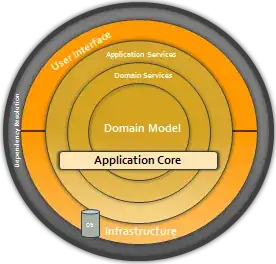There is a big difference between the application layer and the presentation layer from a DDD view point.
Although DDD centers around how to model the domain using the DDD building blocks and concepts such as bounded contexts, Ubiquitous language and so, it is still vital to clearly identify and separate the various layers in your app.
The architecture plays a big role in implementing a successful DDD app. A famous architecture that gained a lot of hype lately is the onion architecture:

In this design the UI/Presentation layer and the application layer are clearly separated. Merging the 2 together introduces tight coupling between 2 layers that have clear separate concerns and responsibilities.
The Presentation layer should only house presentation logic. Avoid Smart UIs that know too much. This mainly houses the MVC's Controllers and views in addition to CSS, JS, templates, forms and everything that relates to response and request objects.
The actions issued through presentation are delegated to the application layer through commands. The application layer contains the application logic. It normally maps to a use case. It contains WHAT the system should do to satisfy a use case. A typical application service will ask a repository to return an aggregate then invoke an action on that aggregate.
Have a look at the sample project from Vaughn Vernon's IDDD
